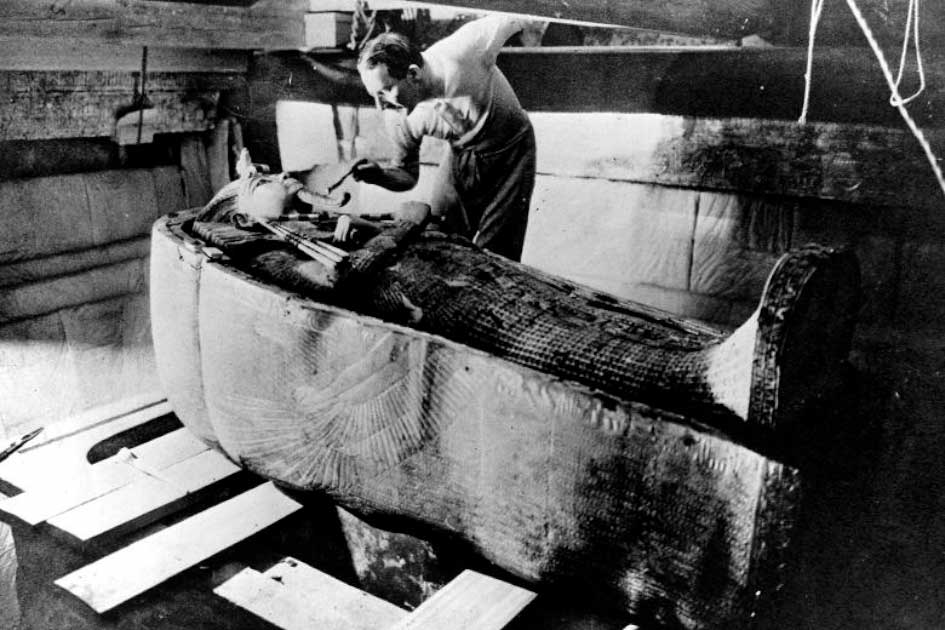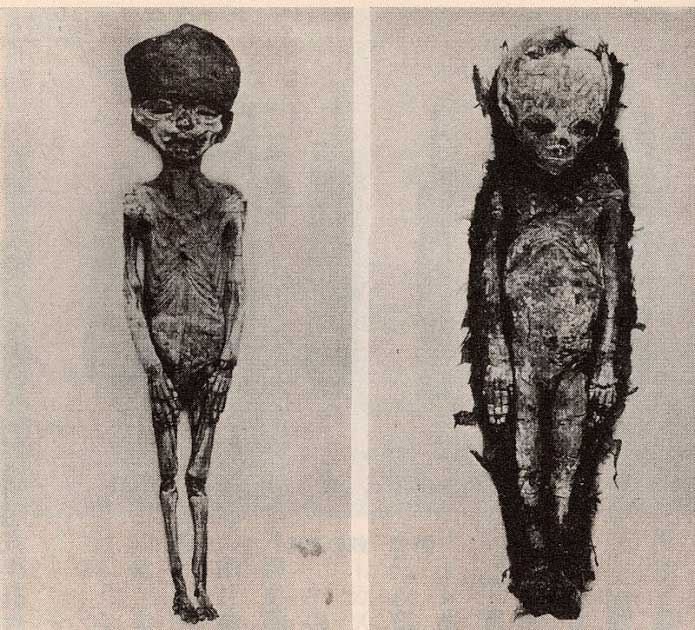Of all the Egyptian Kings we have learned of and whose mummies we have uncovered the most famous has to be King Tutankhamun. The discovery of his tomb in 1922 and what was found within has shaped how we have viewed the ancient Egyptians for the last hundred years.
To this day we are still trying to explain some of the things Howard Carter and his team found within it. Most confusing and perhaps, disturbing, were the mummies of two babies found near King Tut’s sarcophagus. Who were these babies and why were they buried with Egypt’s most famous ruler?
Infant Victims?
When Carter and his team finally cracked open king Tut’s tomb they found a true treasure trove: 5,398 items were catalogued within. Most famous is probably King Tutankhamun’s solid gold coffin along with his golden death mask, decorated with lapis lazuli.
Alongside these two major finds were other treasures such as thrones, bows, instruments, and statues. There were more mundane discoveries too such as food, wine clothing, and even fresh underwear.
It took Carter 10 years to catalog all the items found within Tut’s tomb. While all the discoveries helped shape our understanding of Egyptian burial rites, the fact is today none of the above items are very surprising. The Egyptians believed in sending their dead into the next life with everything they might need, including a fresh pair of pants and some food for the road.

What was strange, however, were the bodies of two babies which were found in King Tut’s tomb. It wasn’t particularly unusual for loyal servants or spouses to end up buried with their high profile dearly departed, but babies? That was much more unusual.
The discovery raised disturbing questions. Had the babies been sacrificed to join King Tut on his final journey? Well, genetic analysis of the two babies (known as 317a and 317b) has shown that both children were most likely stillborn. It is believed they made it to around 25 weeks of gestation while 317b was a little later, making it to 37 weeks. At 40 weeks they might have had a chance of survival.
It is believed the babies were the children of the great Royal Wife, Ankesenamun, who also happened to be King Tutankhamun’s half-sister. The fact neither child made it is sadly, unsurprising.
King Tut and his family were a rather sickly lot thanks to in-breeding. During this period the Egyptian royals tended to keep to themselves, genetically speaking. King Tut’s parents had been siblings and he had married his half-sister. It is known that he had a cleft palate, a club foot, and a genetic bone disease, all thought to be as a result of decades of incest.
It seems most likely that since King Tut only had one wife both babies are his by his half-sister, Ankesenamun. DNA tests have shown the babies to be more than a 99% match with King Tut. Tests on both babies have shown they would have likely been born with birth defects if they had survived.
Another theory is that the two children were actually murdered. It has been hypothesized that their miscarriages were induced in order to clear a path to the throne for those awaiting King Tutankhamun’s death. While this is a tantalizing theory, there is no evidence to support it.
Why Was he Buried With Them?
It is believed that the two stillbirths happened shortly before or around the same time as King Tutankhamun died. This leaves us with the question of why he was buried with them. The Egyptian royal family wasn’t known for being mean when it came to burials. They could have easily afforded grandiose tombs for the two babies alongside King Tut’s.
The sentimentally minded of us might wish to believe their burial with their father was an act of love. That King Tut wished to enter the afterlife besides the two children he never knew so that he could meet them on the other side. Unfortunately, prominent Egyptologists think something else is much more likely. The babies were King Tutkhamun’s insurance policy.
- Iron in the Bronze Age: Where did Tutankhamun get his Dagger?
- Egyptian Monotheism? Akhenaten, the Heretic King
Egyptian burial rites were all about ensuring safe passage to the afterlife. Everything was placed in a tomb for a reason. In Ancient Egyptian art women and girls were often depicted as being protectors, standing alongside their fathers as guards. It is believed both 717a and 317b were likely girls.
As such it is believed that the two baby girls were placed in the tomb with their their father as guards. It was their job to protect King Tutankhamun’s spirit as it traveled to the afterlife.
Later discoveries have found this practice wasn’t actually all that uncommon. The burial of royal children alongside their fathers wasn’t unprecedented during the 18th dynasty. Both Amenhotep II and Thutmose IV were buried with children who seemingly died before them.
The only peculiar thing about 317a and 317b is how well looked after their bodies were. Both were individually mummified, wrapped up, and placed in their own coffins, which makes them incredibly rare.
The Gift of Immortality
So the two babies buried with King Tutankhamun were his two stillborn daughters. While their burial with their father may have sent alarm bells ringing at first it seems there was nothing sinister at work.
Instead, the babies were sadly victims of the Egyptian royal family’s incestuous habits. Rather than get their own burials they were chosen to guard their father into the next life.

The discovery of 317a and 317b helps reinforce what we already knew about the ancient Egyptians. They were obsessed with making safe passage to the afterlife and their complex burial rites were little more than a collection of insurance policies. For King Tut, being buried with his children was the ultimate backup.
Top Image: Tutankhamun’s tomb contained many treasures, including two of his infant relatives. Source: Jaroslav Moravcik / Adobe Stock.